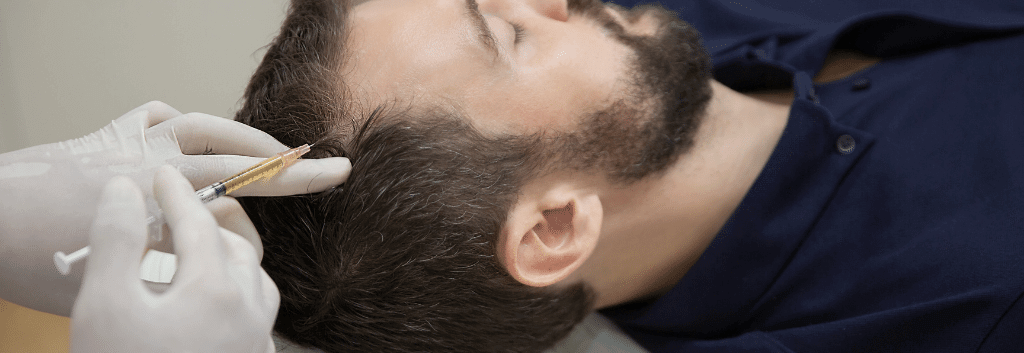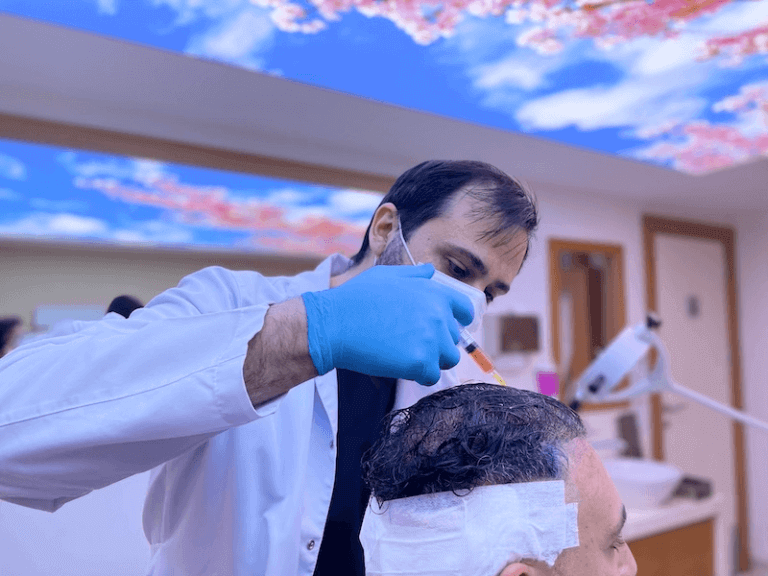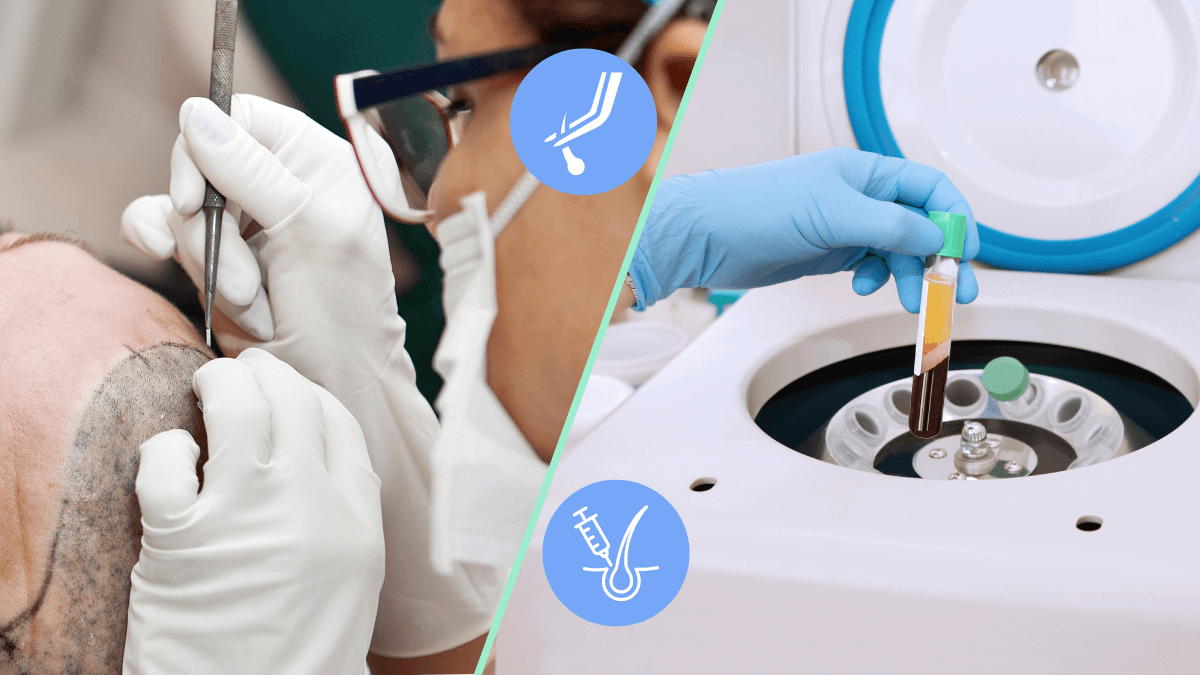Table of Contents
You’ve come across a dozen treatments that are said to help with hair loss.
You’ve tried to look up the most common and scientifically proven treatments, and two options stand out:
Hair transplants and PRP therapies.
Without going into further detail, I can say that both treatments are very effective, backed by a significant number of research and studies. Their effectiveness is not the question here.
It’s whether they are the best treatment for you or not.
So which is better, PRP or hair transplants?
Or are they even in the same category?
Platelet-rich Plasma Therapy (PRP) for Hair Growth
PRP therapy for hair loss is a non-surgical and non-invasive operation where the patient’s own blood is used to promote hair growth.
PRP therapy has three steps:
- Withdrawal: The process begins with a small blood draw, similar to routine lab work.
- Centrifugation: The blood is then placed in a centrifuge, separating the red blood cells from the plasma rich in platelets.
- Injection: Finally, the plasma that’s rich in platelets, hence PRP, is injected into the scalp in the areas where hair growth is desired.
Platelets that make up the PRP injection are rich in growth factors such as platelet-derived growth factor, vascular endothelial growth factor, and transforming growth factor.
These growth factors stimulate cell growth, proliferation, and differentiation, which promotes the healing and repair of damaged tissue.
In the case of hair loss, male-pattern baldness is the most common reason behind it, and the growth factors in PRP help hair follicles that are damaged and shrunk by DHT.

A decent number of studies agree that PRP injections around balding areas of the scalp can help promote hair thickness and growth in existing follicles while slowing/stopping hair loss.
Advantages of PRP
Let’s take a look at the upsides of getting a PRP therapy to treat your hair loss:
The treatment is non-invasive and has no downtime
PRP treatment is non-invasive, meaning that there is no surgical procedure involved. The blood withdrawal and PRP injection steps of the treatment are made in a matter of minutes with minimal pain.
And right after a PRP injection, you can resume your daily activities, which makes it a pretty appealing treatment for people with busy work lives.
It can be combined with other common treatments
Chances are, PRP alone will only slow down your hair loss. You might need to combine it with other treatments, which it perfectly does, to stop it.
Oral finasteride is the treatment that’s most commonly combined with PRP therapy for people in the early stages of pattern baldness. It provides a definitive stop to hair loss.
It can also be combined with hair transplants for people with advanced and visible hair loss to restore hairlines and promote growth in recipient sites.
Disadvantages of PRP
PRP therapy has downsides as well. Let’s take a look at what they are and why they matter:
It is not effective in treating advanced stages of hair loss
Once a hair follicle dies, there is no way to revive it, no matter how much growth factors you inject into your scalp.
So, once an area on your scalp has completely gone bald, PRP won’t be able to help you promote new hair growth on that site; actually, no treatment does that.
The results don’t come in immediately; they add up over time
PRP therapy helps your body aid your hair follicles by increasing the number of growth factors on the site. It doesn’t directly address hair loss.
Getting significant results can take up to 6 months, and even though most patients get positive results, the degree of improvement can’t be predicted.
Hair Transplant Surgeries
A hair transplant surgery is where donor hair harvested from the back of your scalp is implanted on the balding areas to restore your hairline and provide you with a full head of hair.
More than 700K people have a hair transplant surgery annually, and that’s only the number reported by ISHRS members.
The most common hair transplant methods are FUT and FUE (and variations of FUE), which both follow the same steps except for the graft extraction part:
- The surgeon examines the scalp of the patient, decides on the graft count, and they draw the desired hairline
- The patient is then injected with local anesthetics to eliminate pain
- Donor hair is harvested from the donor area and is stored in a proper liquid until the implantation step
- In FUT, this is done by extracting a strip of tissue from the back of the scalp and then harvesting individual follicles from it,
- While in FUE, harvesting is done directly at the donor site with a special punch tool that minimizes scarring.
- Using implanter pens or special forceps, the extracted hair is then implanted into the recipient area, and the hairline is restored.
Patients will see significant improvements just a few weeks after the surgery, and complete results are expected 6-12 months following the operation.

Advantages of hair transplants
Here are the top advantages of a hair transplant:
Provides more immediate and visible results
A hair transplant is a direct treatment for balding where the surgeon aims to restore your desired hairline by directly implanting hair follicles into the bald areas.
The results are much more significant and noticeable earlier than most treatments.
The results are permanent if maintained properly
The hairs harvested from the back of your scalp are immune to DHT, therefore, are not affected by genetic hair loss.
When implanted into the balding areas of your scalp, these hair follicles maintain this characteristic and don’t fall out for a long time, so most of what you get after a hair transplant is permanent.
Disadvantages of hair transplants
Getting permanent and more visible results comes with its downsides, naturally.
Let’s take a look at the most important ones:
It includes a surgical procedure
Hair transplant surgeries, as you can get from the name, are surgeries that should be done by surgeons in a proper setting.
The surgery can take 4-8 hours, depending on the graft count and the method used. You won’t be able to return to work or other daily activities for a while until the initial healing process ends.
Also, since it is a surgery, there are risks of scarring and infections, and you are expected to feel discomfort for a few days following the surgery.
You will need to invest a significant amount of resources at one go
Unlike PRP therapy or medications such as finasteride or minoxidil, hair transplant surgeries require you to invest a significant amount of time and money in one go.
You must allocate at least a week for the surgery and the initial healing process afterward while also paying for the whole procedure right before the surgery.
PRP vs. Hair Transplants – what you need
Both PRP therapy and hair transplants have their own use cases that come up with unique advantages and disadvantages.
As a dermatosurgeon who does both PRP and hair transplant treatments, I can suggest PRP without any hair transplant to some patients, but I won’t suggest hair transplant without PRP, since it is crucial in achieving success with your hair transplant.
So, let’s see if you should just get PRP or if you should get both:
Get PRP if: 💉
- Your hair loss is in its early stages
- You want just to slow down your hair loss
- You are uncomfortable with the idea of an actual surgery
- You don’t have the time or the resources that a hair transplant surgery requires
Get both hair transplant surgery and PRP if: 👱🏻♂️ + 💉
- Your hair loss has progressed and is visible
- You want to restore your natural hairline
- You want more immediate results that are much more noticeable
- You are comfortable with the idea of a surgical procedure
Restore your natural look with a dermatosurgeon
The wide variety of treatments is only a means to an end.
Your goal shouldn’t be to get this or that treatment; it should be to get your hair back and restore your natural look.
That’s why at UnitedCare, to get you the best results possible, we don’t only do hair transplant surgeries but also utilize a combination of PRP, bio enhancements, and a few medications to address each reason behind your hair loss…
… so you never have to worry about losing a hair follicle ever again.
Get a Hair Transplant and a PRP – achieve the best results possible
Schedule a free consultation, let us see what we can do
Frequently Asked Questions (FAQs)
Which is better, PRP or hair transplant?
PRP is better if your hair loss hasn’t already progressed much, and you can support your scalp in protecting your existing hair, while hair transplants are the obvious choice if your balding has progressed and you need to restore your hairline.
Does PRP grow new hair?
Once a hair follicle dies, it can’t be restored, so no, PRP can’t help with lost hair. It can help support existing hair and give it a thicker look, but you need hair transplants to get new hair in the balding areas of your scalp.
Can PRP replace hair transplant?
PRP supports existing hair follicles, while hair transplants restore your hairline by implanting hair follicles in the balding areas of your scalp, so PRP can’t provide the same results as hair transplants. They provide the best results when used together.

